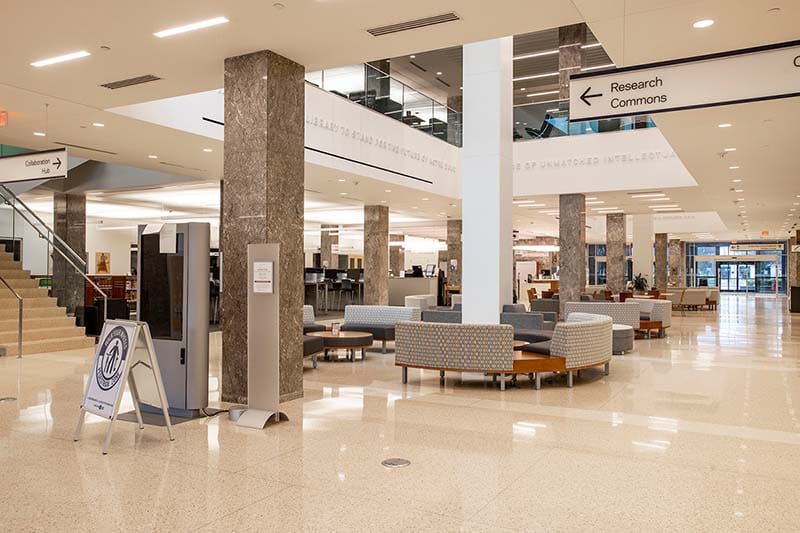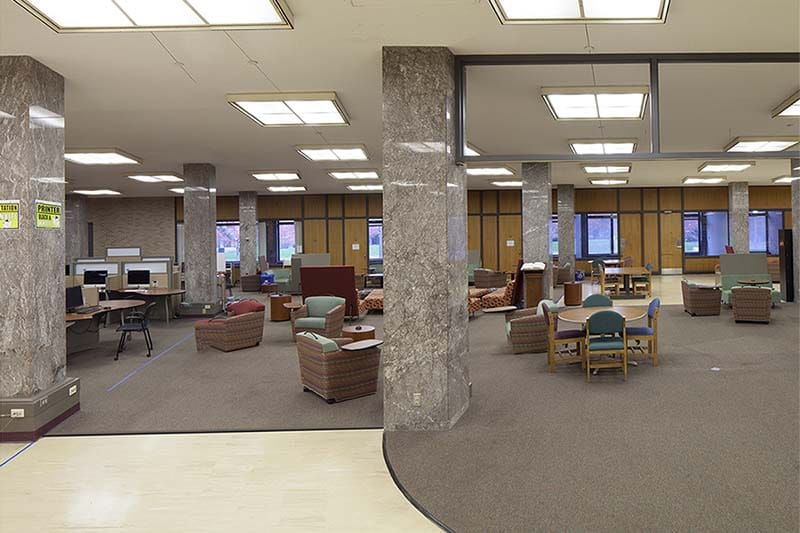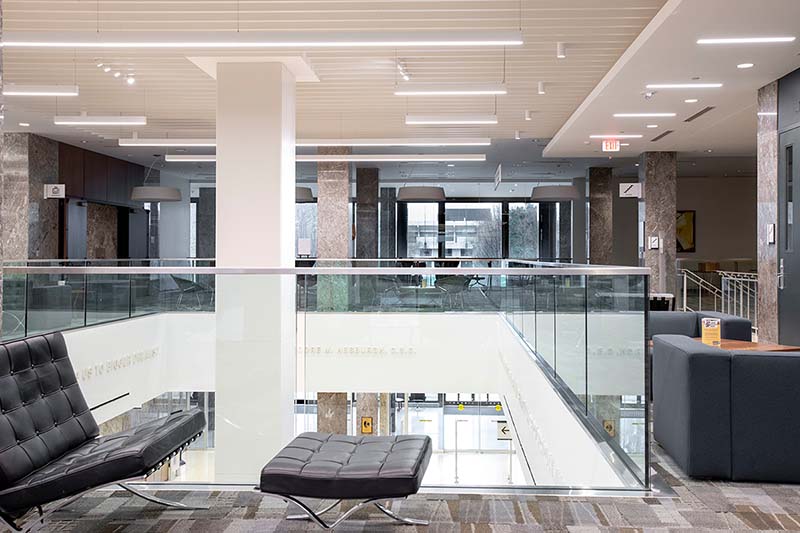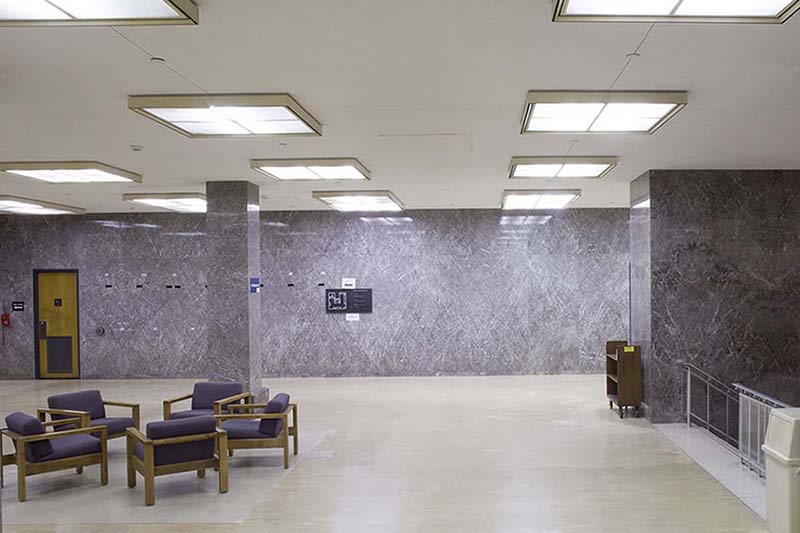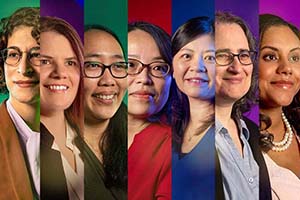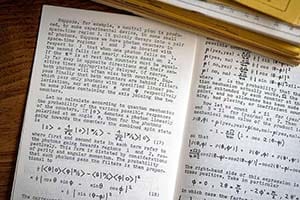
A few years before he died, Rev. Theodore Hesburgh, C.S.C., sat at his desk on the 13th floor of the library named after him, a cigar smoldering in the ashtray, telling jaw-dropping stories despite his diminished vision. One involved a future pope.
Father Hesburgh invited Giovanni Batista Cardinal Montini to Notre Dame in 1960 to preach at the baccalaureate Mass and receive an honorary doctorate. The two priests spoke Italian and took walks to every corner of the campus, building the foundation of their long friendship.
In his autobiography, Father Hesburgh wrote: “The new main library was just a hole in the ground at the time, and I described our plans for a new three-million-volume library.” On this day in his office, he told the rest of the story.
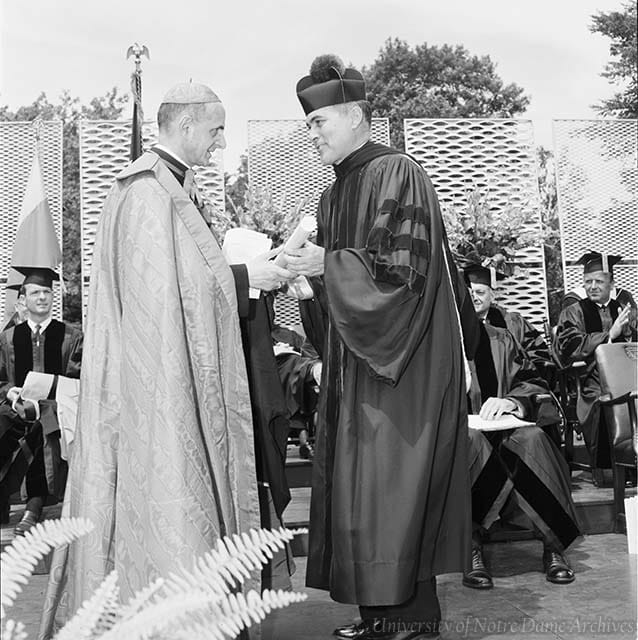
Cardinal Montini asked him if he had already raised the money to build the then-largest college library in the world. Father Hesburgh said no, only a part of the money. Cardinal Montini asked why he would dig the foundation without knowing whether he would complete the fundraising.
“Cardinal, you have to have faith,” Father Hesburgh told the future Pope Paul VI, flashing his trademark smile.
Fifty years later, the University began a major renovation project by looking back at Father Hesburgh’s original vision before re-imagining the library’s role for the next 50 years. The partially completed project aims to overhaul the look, services and use of the library for the digital age. The multi-million dollar re-construction shows that current University leadership shares Father Hesburgh’s faith in the library’s core mission: connecting people to knowledge.
The Word of Life mural on the building’s southern wall, popularly known as Touchdown Jesus, aptly illustrates this mission. It tells the story of Christ the teacher, with generations of scholars transmitting knowledge from one generation to the next across the ages.
“I wanted in 1963, and still desire today, for the library literally to stand for the future of Notre Dame as a place of unmatched intellectual achievement, free inquiry, and providential contributions to mankind,” Father Hesburgh said in an interview for a book about the library’s 50th anniversary. “Let the library be a place on this campus where that hunger for truth will keep getting stronger, supporting freedom and justice around the world, inspiring excellence, and prodding us to bigger dreams.”
Yet how to achieve that goal has changed dramatically. Books are still the core resource of any library, but expanding the rows and rows of bookshelves could not possibly keep up with the ways students and faculty create new knowledge, the pace of new information being published or how scholarship is disseminated today.
Over the last six years, the renovation project has literally reshaped key areas of the building to focus on the expertise, services, distinctive collections and spaces that enhance teaching, learning and research for and in collaboration with the University community.
Opening up
The most obvious changes in the Hesburgh Library have opened up a new entrance, rearranged its traffic alignment and unclogged the first and second floors. These changes, accomplished in phases to avoid closing the whole library, unlocked the potential for more collaboration and technology in common and private spaces.
More than a century after the University’s founding but within a decade of opening the 14-story library, Father Hesburgh opened the doors of Notre Dame to female students in 1972. In recognition of that transformative decision, a group called Women of Notre Dame came together and decided to make its first initiative a new entrance to the Hesburgh Library on the north side.
A steering committee led by Anne Thompson (’79) and Cindy Parseghian (’77) brought in more than 1,400 donations to create the North Entrance, which opens into a new Entrance Gallery and changes the east-west traffic pattern into more of a crossroads. A special mosaic of Father Hesburgh comprised of donor images commemorates the change.
A new skylight was added and a huge chunk of the first-floor ceiling was removed to open up the Entrance Gallery, flooding the space with much-needed light. Additional windows above the south entrance unveil a dramatic view of the library quad and stadium.
Rather than all book stacks, the first two floors now also house modern creations called the Technology Commons, the Collaboration Hub and the Navari Family Center for Digital Scholarship.
The second-floor Technology Commons, designed as high-quality study and work environments, includes computer clusters, tech-enabled collaboration pods, group study rooms, study tables and individual workstations. There are also multimedia studios, a Mac computer lab and a room for copying, printing and scanning.
Likewise, the two-story Collaboration Hub is designed to support interdisciplinary research, multimedia projects and collaboration among faculty, staff, and students. It has classrooms, group study rooms, videoconferencing and more. The first-floor Research Commons houses many of the subject librarians that had been scattered throughout the library before.
New spaces are nice, but they are only as effective as what goes on inside them. One example of an innovative new service is the Media Corps support group, a team of undergraduate coaches trained to help anyone learn how to capture, edit and produce digital media.
Media Corps and Remix, an open-access website featuring step-by-step guides and showcases for multimedia projects, grew out of a partnership with the Kaneb Center in DeBartolo Hall, which helps faculty integrate technology into their courses.
Renovated spaces
Ashley Decker worked during her freshman year with Kaneb Center’s Chris Clark, who wanted to create something like a Writing Center for multimedia projects. Decker then worked with Clark (now retired) and Randy Harrison, emerging technologies librarian, to create the content for Remix and train the six coaches for the inaugural Media Corps cohort. Both launched in fall 2018.
Decker described a typical recent appointment. A graduate business student needed help designing a promotional poster for black history month, but she had little experience in design or Photoshop.
“She wanted something distinctive,” Decker said. “I showed her Canva, which is more user-friendly than Photoshop, and suggested a few design ideas. We had draft mockups in about 15 minutes.”
New services
Kaleigh Brauns learned the value of the Collaboration Hub in her freshman year when faced with her first major research paper. She decided to write about the prescription drug industry.
A meeting with Melissa Harden, a first year experience librarian, led her to economics books, online databases of court cases, dissertations on health care and interlibrary loans for the information she needed.
Brauns’ research paper won the First Year Student category for a University of Notre Dame Library Research Award, a contest the library holds each year to honor students who use a breadth of library services and demonstrate exemplary research skills. In an essay for the award, Brauns wrote that library resources made possible her “cohesive and comprehensive” paper, titled “Manufacturing Monopolies: Why Drug Manufacturers are at the Root of the Recent Rise in Pharmaceutical Prices.”
“It is the product of months of extensive research and analysis that would not have been successful if it had not been for the incredible services and support offered by the library,” Brauns wrote.
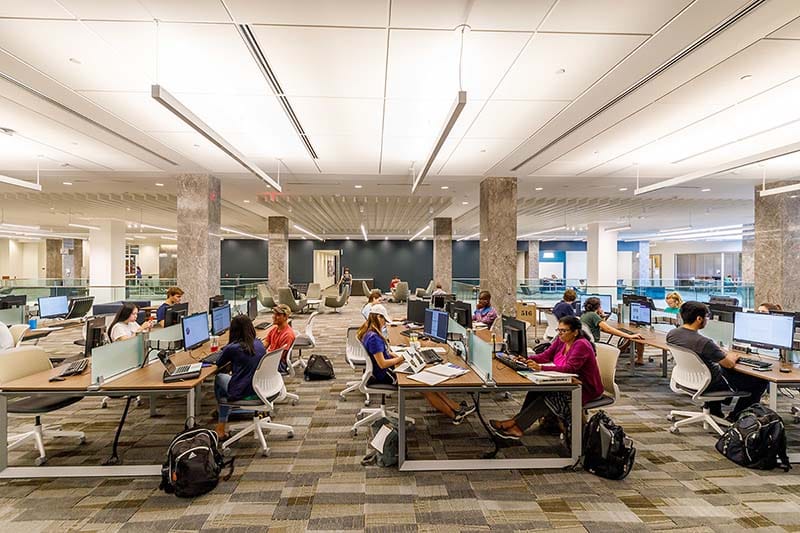
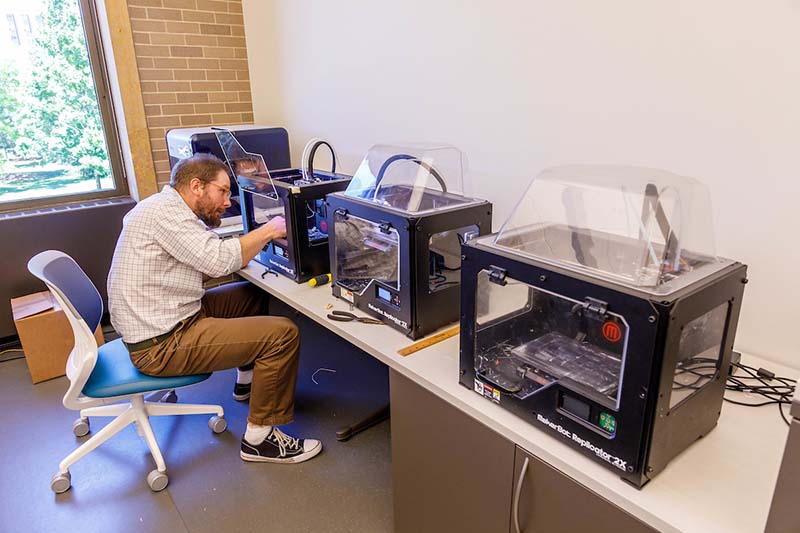
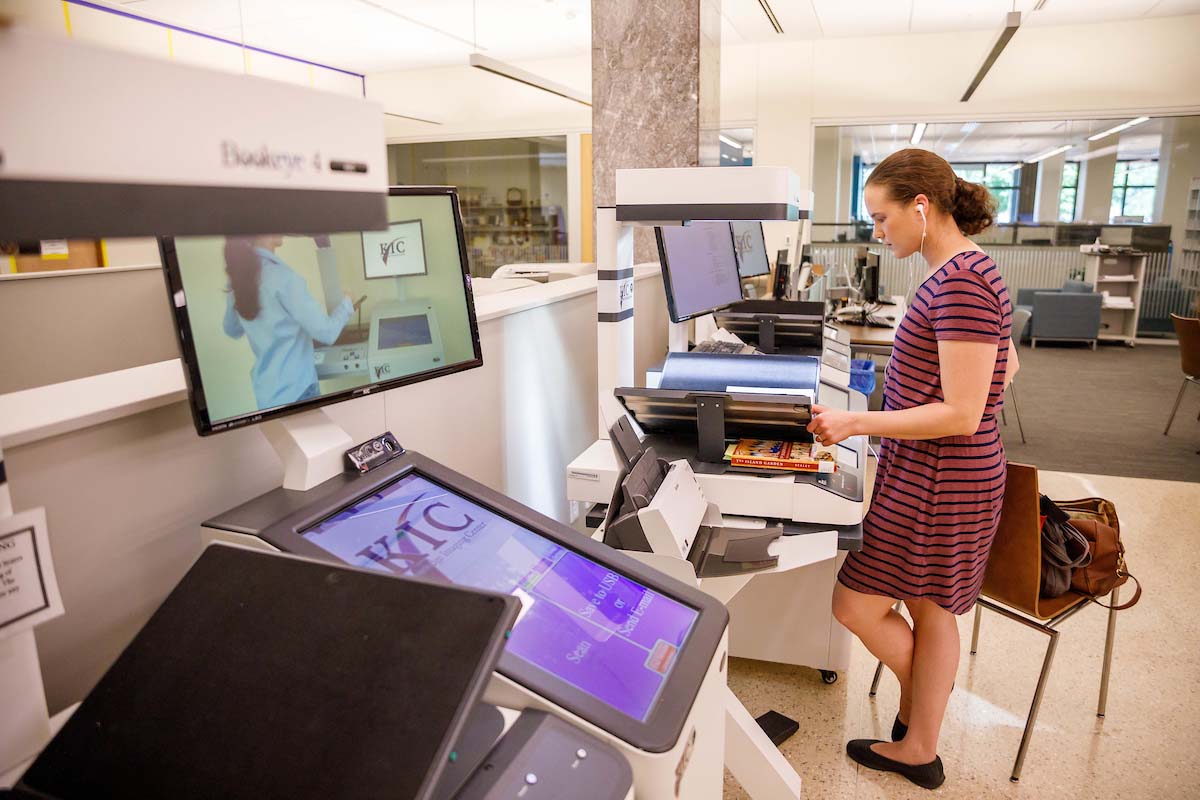
Another new space and suite of services, the Navari Family Center for Digital Scholarship (NFCDS), officially opened in June 2018. It aims to help students and faculty explore emerging technologies and methodologies, as well as analyze complex data and share research results in ways never before possible. It includes a lecture-capture classroom, data visualization studio and a technology room with loanable equipment and 3D printers, plus computers with specialized software and transcription capabilities.
“With this technology, it’s possible to reach new groups in our research.” — Susan D. Blum, anthropology
Anthropologist Susan D. Blum has been teaching and publishing research at Notre Dame since 2000. After her latest book — “I Love Learning; I Hate School: An Anthropology of College” — she conceived an idea for an unprecedented project.
“I’ve been studying school ethnographically for years,” Blum said. “I’d been thinking about how to solicit people’s stories, which often have lots of emotion, both positive and negative. I decided I wanted something more modern than the traditional interview, something like citizen science where we could crowdsource stories.”
In addition to conventional publication, Blum has incorporated digital media into her teaching and research for years, but the technical requirements of this project were at a higher level. The skills of the undergraduate and graduate students on her team were impressive, but, “This is a whole new realm,” she said.
The online platform she envisioned would release a new story prompt each week. It would need to accept contributed audio and visual files in addition to written stories, and there had to be a data organization structure that would allow users to sort and search for information. It should be a two-way interaction, international, scholarly and potentially anonymous.
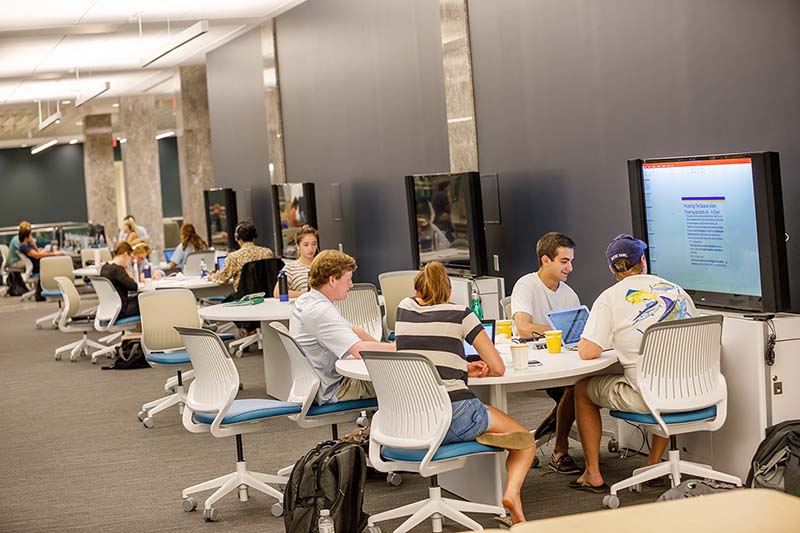
A friend led her to Julie Vecchio, the NFCDS assistant director who Blum called “her guardian angel” for directing her research team to experts who could help solve their technical challenges. Over several meetings, the consultants and the team explored digital tool options, prototyped and tested an online submission form, and discussed a variety of considerations related to data collection, processing, and curation.
The “School Stories” website is scheduled to go live by this summer at the latest. “This isn’t new for the sake of newness,” Blum said. “With this technology, it’s possible to reach new groups in our research.”
Final phases
While the first and second floors are the centerpiece of the library’s renovation, other floors are also getting a makeover. The Lower Level and Penthouse floors were renovated earlier.
The updated fourth floor has consolidated several service units and some library faculty and staff offices that were moved from the first floor, freeing up more space for public services and subject librarians who interact with library users on a daily basis.
“We know that our vision for transforming the Hesburgh Library is bold.” — Diane Parr Walker, University Librarian
The 10th floor renovation serves as a test and model for the renovation of the other tower floors. Originally these floors were designed to have few walls, while the bare columns created a flexible space to arrange stacks of books. The windows were intentionally small to reduce glare and avoid uneven light from outside.
Now, the old-fashioned study carrels were replaced with lighted study tables and comfortable seating around newly-exposed windows. The 10th floor also features a Graduate Student Enclave with assigned carrels, and a History Reading Room. Rows of stacks filled with books still remain so that faculty and students have space to do their research in and among the materials they are studying.
Library and University leaders are still fundraising for the final phases of the renovation. Besides the remaining six tower floors, a two-story Grand Reading Room and an expanded Specialized Collections and University Archives are envisioned.
“We know that our vision for transforming the Hesburgh Library is bold. We also know it is critical in order to meet the rapidly-changing needs of faculty and to prepare all our students for success both in the classroom and in their chosen professions beyond Notre Dame,” said the Edward H. Arnold University Librarian, Diane Parr Walker.
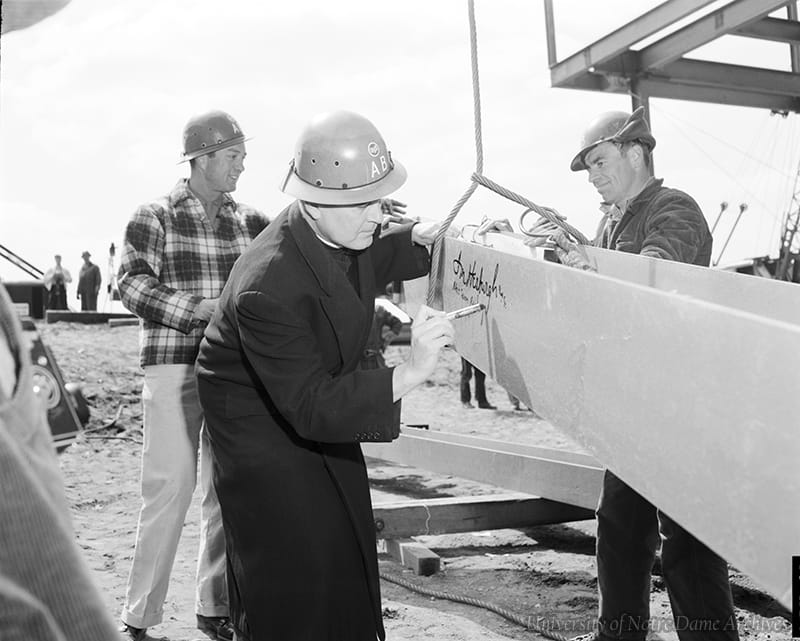
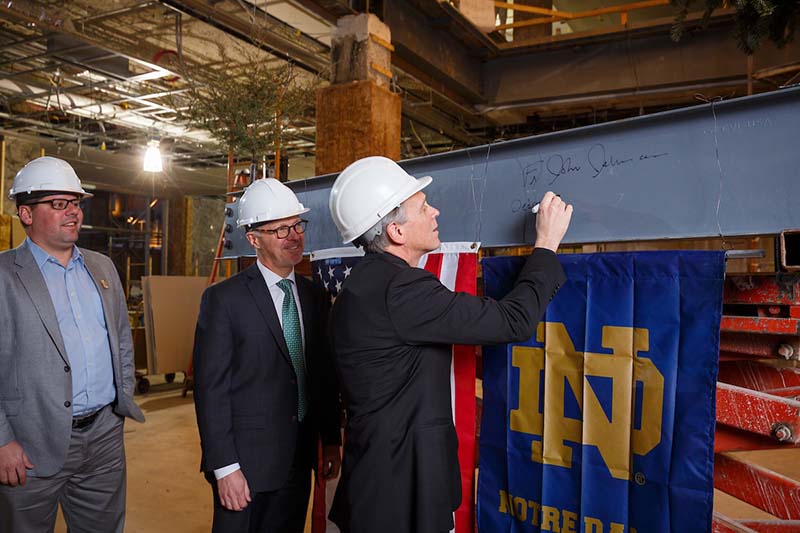
In January 2016, construction workers placed the final beam for the new Entrance Gallery. The traditional topping-out ceremony intentionally mirrored the one where Father Hesburgh signed the final library beam in the 1960s. President Rev. John I. Jenkins, C.S.C., signed the gallery beam and reflected on why a renovation was appropriate 50 years later.
“Given the ever-changing environment of the digital age,” Father Jenkins said, “now is the time to make a transformational leap forward through a bold renovation that will keep the Hesburgh Library the centerpiece of Notre Dame’s intellectual pursuits and an enduring symbol of our academic excellence.”
